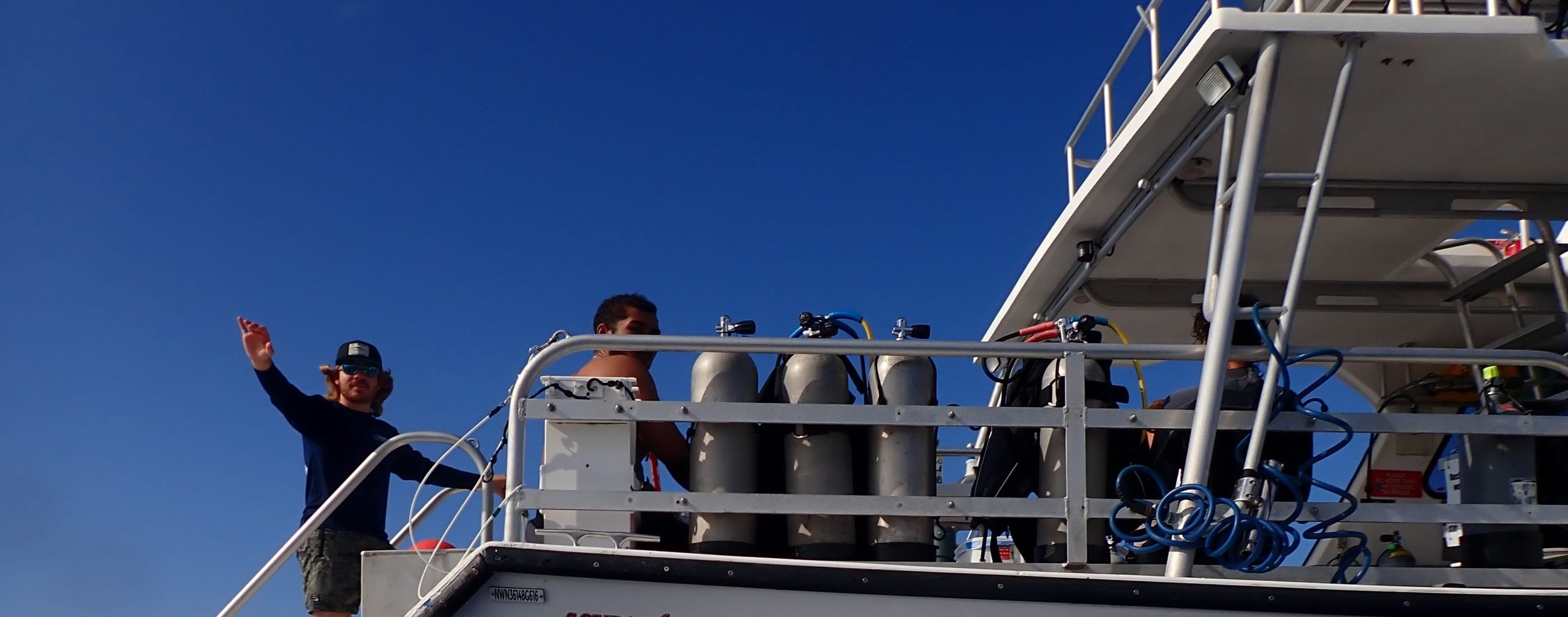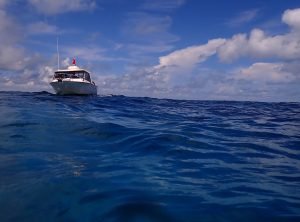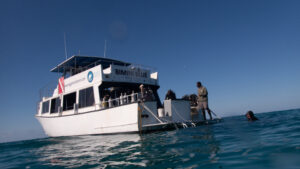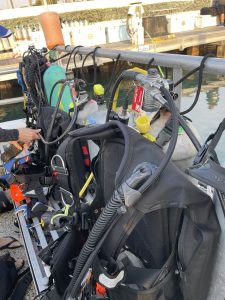A Guide to Scuba Dive Boats

Welcome, fellow underwater explorers! As you embark on your scuba diving journey, understanding dive boats is crucial to you having a good time diving off of them. These vessels are your ticket to exploring the beautiful world beneath the waves. In this guide, we will discuss different types and sizes of dive boats. Additionally, we’ll give you a few etiquette tips. Hopefully, we will unravel the mysteries of dive boats so that new scuba divers will be well-prepared when they first step foot on a boat. From types and sizes to essential amenities and etiquettes, let’s ensure your diving experiences are smooth sailing.
Understanding Dive Boat Sizes
Dive boats come in various sizes. Each size has advantages and disadvantages. There is no right-size boat, just the right size for the group and dive site. When you are considering booking a trip with a boat, think about your style of diving and the group size you are comfortable with. In all cases, call and talk to the boat operator if you have any questions or concerns. I’ve never run into an operator that wasn’t willing to answer all my questions about their boat. If I do, it’s a sign I need to keep looking.
RIBs (Rigid Inflatable Boats)
These lightweight, inflatable boats are perfect for reaching remote or shallow dive spots. Their flexibility allows you to explore hidden gems that larger vessels might miss. RIBs are most commonly used as dive boats in areas with diverse and challenging underwater landscapes. They are especially popular in regions where access to shallow or remote dive sites is necessary.
Because RIBs are challenging for divers to get back into most divers will shed their gear in the water, crawl aboard, and then hoist their gear onboard. This can be difficult for those that struggle with balance or lifting heavy weight. If this is a concern for you and you know you will be diving on a RIB, talk to the crew beforehand. They will almost always be willing to help you get into the boat and/or get your gear aboard.
Because of their size and the dive gear on board, most RIBs have few amenities if any at all. Since they are used for near shore sites or sites near to a larger boat, amenities are usually not far away.
Small Boats

Small scuba dive boats are ideal for intimate diving experiences. Many small boats are referred to as 6-packs because they hold a maximum of six divers. A 6-pack will provide a close-knit atmosphere and they are especially fun if you are diving with friends. Because of the limited number of divers on the boat, the experience is usually custom-tailored to the group. This makes them perfect for beginners, and those divers looking for relaxed dives or specific dive sites.
Small boats usually have limited amenities. A 6-pack may have a small water cooler for fresh drinking water but that is usually the extent of it. Because there is a little more room than on a RIB, divers can usually pack a snack in their dry-bag for the surface interval.
Medium-Sized Boats

Medium-sized boats balance intimacy and amenities. They offer more space than small boats, allowing for a comfortable journey without feeling overcrowded. Medium-sized boats usually take 6-12 divers at a time. Beyond that, a medium sized boat will most likely have things like:
- Fresh Water Hose
- Fresh Drinking Water Cooler
- Marine Head
- Dry-bag Storage Areas
Like a 6-pack, one of the major advantages of a medium sized boat is that you get more attention from the staff. Boats of this size usually have 2 staff members, a captain and a deck hand/in-water guide. With a maximum of 12 divers, the deck hand can give each diver more personal attention.
Large Boats

Large dive boats carry between 16+ divers at a time. When it comes to amenities, they vary greatly from boat to boat but most will at least have the basics of a marine head, fresh water for rinsing off divers (not gear) and fresh drinking water. Beyond that, some have camera buckets available, others will have ice-chests for divers to store snacks, and drinks of their own. Many boats of this size will also have snacks and sodas onboard.
A major advantage of large dive boats is that they usually have 3-member crews.
- Captian
- Deck Hand
- In-water Guide
This means that even though you have more divers, there’s more people on board that can help you with gear problems.
The decks are larger but with more people, they may seem smaller. Still, larger dive boats can take divers farther off-shore and be stable in rougher seas than small or medium-sized boats.

One of my favorite types of this size boat has a dive deck on the back. It is the uncovered part of the deck where gear is set up on tanks. Then there is a large covered area forward where divers can relax on their way to and from the dive site. These boats also usually offer a large upper deck for divers to roam. Because they are so spacious, these are great for those longer trips out to the dive site.
Extra-Large Boats
Then there are the big boats. These dive boats carry 20+ passengers. It’s not unusual for these boats to be loaded with amenities only dreamed of on smaller boats. In addition to all the things found on large boats, extra-large boats can offer things like:
- Hot/cold freshwater shower
- Spacious cabin with A/C and heat
- TV/DVD
- Refrigerator
- Drinking fountain
Because these boats typically run to sites farther off-shore than other boats, the extras help make the trip more bearable.
These boats are close to small liveaboards.
Dive Boat Essentials and Safety Measures
Regardless of the boat you are diving off of, there are some things that never change. These are the things that you as a diver need to know about your boat before it leaves the dock with you on it.
Roll-Call
When you call to book your trip, ask if the crew takes roll after each dive. If the crew does not take roll after each dive, find another dive boat operator with which to dive. The larger the boat, the more important that roll is taken between each dive. Without it, it is easy for a diver to be overlooked and left in the water. It’s not a hard-and-fast rule. When I am diving a 6-pack with the lovely and talented Kathy and 4 of our friends, no, we don’t bother taking roll because we will know if someone is missing. That is about the only time I don’t insist on roll being taken on a dive boat. The 60-second investment in making sure that everyone is back on board before moving the boat is time well spent.
Dive Deck Layout
Understanding the layout of the dive deck is crucial. Familiarize yourself with where your tanks go, where your gear goes, and where extras like your gear bag are stored during the trip. During the boat briefing the crew will familiarize you with entry points and how to exit the water. Knowing this will ensure a smooth transition from gearing up to giant stride. (Or my personal favorite, the back roll.)
Safety Gear
Regardless of the size of the boat, every member of the crew should be trained in first-aid and diver rescue. They will know where the first aid kit is as well as where the Oxygen kit is stored. The location of these items should be announced during the captain’s briefing; if they aren’t, ask. If the boat doesn’t have both items, find another boat. If you are told the crew will get them if needed, find another boat. Even if you are not rescue certified and not trained in giving O2, knowing where these items are is important. The hesitancy to tell you this information should be a yellow flag in every diver’s mind.
Safety First
A reputable dive boat operator prioritizes safety over everything else. Before every dive, crew members conduct equipment checks to help you ensure your gear is functioning correctly. Additionally, detailed briefings should be conducted, guiding you through the boat’s features and safety protocols.
Dive Boat Etiquette
There are rules on every dive boat. Many of the rules are covered in either the Captian’s briefing before the boat gets underway or the Crew Briefing as the boat is making it’s way to the first dive site. Many of the etiquette rules aren’t written down but are just part of the dive boat’s culture. They are important to know.
Here are a few of the rules common on most dive boats.
Punctuality Matters
Arrive on time. Unless you are chartering the entire boat, the boat has a schedule. Everyone is eager to gear up and jump in. If you hold up the boat because you are running late, you won’t be very popular on the trip. Pad your schedule and arrive early if you can. Take the extra time to snap some pre-dive photos or get to know the other divers who will be on your boat.
Mind You Space
Especially on large boats, there are going to be a lot of people bumping around and a lot of dive gear being set up or torn down. Make sure that your gear fits neatly in your space. Stow your dry bag in the appropriate place as directed by the crew. Don’t leave gear or weights lying around where they can fall and hurt other divers or be a hazard for people walking on the boat.
Make Sure Your Gear Is Marked
The larger the boat, the more likely is it that you will have the same gear as another diver. When divers are coming up from the dive, it is common for the deckhand to toss fins in a common area. Make sure your fins are marked as yours so that when you go to retrieve them, you know they are yours. All of my gear is either tagged with small plastic tags or marked with a permanent marker so that there’s no disputing whose gear is whose.
Respecting Fellow Diver’s Equipment: The “Look, Don’t Touch” Rule

This is a fundamental rule in the scuba diving community: the “Look, Don’t Touch” rule. When you’re on a dive boat, surrounded by fellow divers, it’s crucial to respect each other’s equipment.
You might be mesmerized by someone else’s high-tech dive gear, but remember, it’s not a museum exhibit; it’s their personal equipment. Resist the temptation to touch, adjust, or inspect someone else’s gear without permission. Each diver customizes their equipment for comfort and safety, and any changes, even well-intentioned ones, can disrupt their dive experience.
Enjoy the Ride

The boat ride to the dive site can be a great time to relax and enjoy the scenery. Look for marine life. If you’re lucky, you may even see turtles, dolphins, or – depending on where you are – whales! You can also get to know your fellow divers and the divemaster. Ask them questions about the local dive sites and marine life, and share your own diving experiences. If you’re feeling tired, take a nap so that you’re well-rested for the dive. You can also read a book or listen to music to relax.
No matter what you choose to do, make the most of the boat ride to the dive site. It’s a great way to start your adventure and get excited for what’s to come.
Clean as You Go: Leaving Only Bubbles
Dive boats often serve refreshments and some even serve meals during the surface interval. Dispose of your waste properly, utilizing designated bins. Be especially mindful on windy days or rough seas. If you aren’t careful, it’s easy to let a snack wrapper or plastic bag get away from you and into the water. By leaving no trace, you contribute to the preservation of both the marine environment and the boat’s cleanliness.
Tipping the Crew
Tipping policies vary from location to location. Your best bet is to ask what is expected when you book your dive. Many boats have signs prominently, placed so that you can’t miss them prominently telling you that the crew works for tips. Other places do not make it obvious, but you are still expected to tip. In some locations, tipping is not culturally appropriate. When in doubt, ask. On most boats the Capitan is paid by the boat operator and does not expect a tip. They are usually more than happy to discuss the tipping policy with you and let you know what is appropriate.
Wrap Up
With the knowledge of dive boat types, sizes, amenities, and etiquette, you are well-equipped to embark on your next underwater adventures. Remember, every dive boat has its unique charm, offering you diverse experiences. So, choose wisely. It doesn’t matter if your boat takes you out on your favorite late, out into the ocean, or to a nearshore spot like the beautiful Blue Heron Bridge, knowing what to look for in a boat and a boat operator is important for every scuba diver.
Bon voyage, new divers; your aquatic adventures await! Dive Confidently!

Join Our Mailing List For New Scuba Divers
If you like this tip for new scuba divers, join our mailing list. You’ll get a new tip delivered to your inbox each week. Learn to dive confidently!